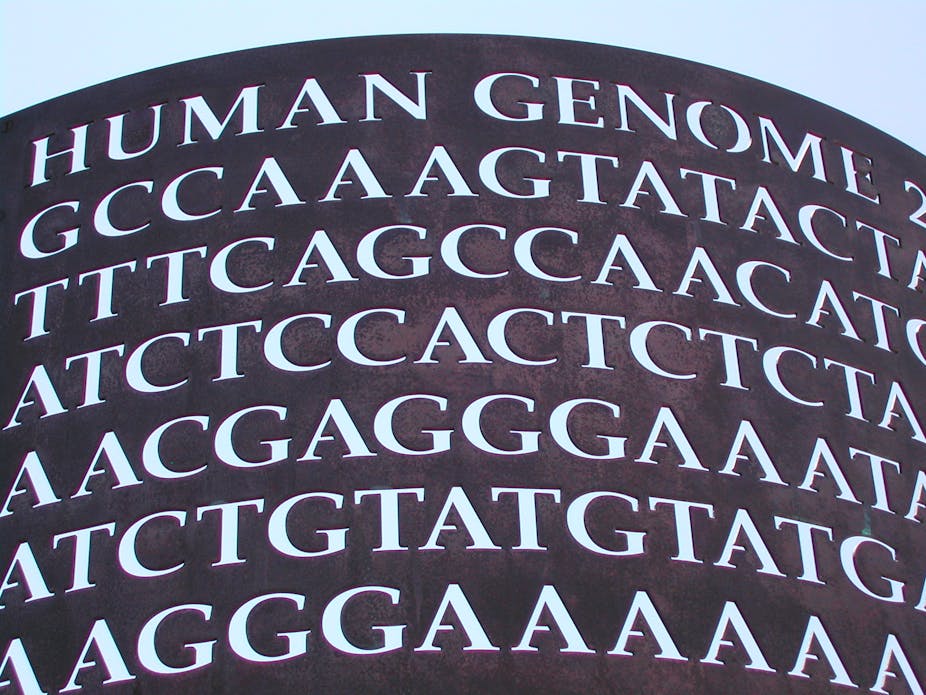An ambitious project has been launched that will involve sequencing genomes of 100,000 individuals to improve our understanding of a range of diseases and – hopefully – eventually find new treatments for them.
The first human genome, sequenced only a decade ago, cost more than £2 billion. But since then the cost of gene sequencing has been tumbling, and we may finally be entering the era of “genomics medicine”.
NHS England has announced which NHS Trusts will become “genomic medicine centres” tasked with collecting samples from selected patients with cancer and from patients and families affected by rare diseases.
The focus on cancer is understandable, because it is a major cause of death in the UK. But why is there a focus on rare diseases?
Rare but important
A rare disease is called so because it affects a relatively small number of people. However, as a group of disparate afflictions, rare diseases affect nearly 6% of people in the UK. Their cause is often genetic and may be first noticed when a child fails to reach the normal milestones in development.
Diagnosis is often difficult because the doctor may not have seen a case before. Sometimes symptoms are quite common and difficult to define, such as tiredness, numbness or pain. There may be no evidence to suggest to the doctor that the underlying cause might be genetic.
The genomic medicine centres recruit patients with the rare diseases in which they already specialise. This is where a better understanding of the underlying genetics of these patients may go a long way to help better diagnosis. But how?
Scale makes the difference
The current difficulty in diagnosis is not because there is no information on rare diseases. Over many years scientists have studied genes that are linked to rare diseases – and these gene-disease links are stored in databases. If family members of a patient are known to have a disease, it might be possible to test a new family member for the disease gene in the database.
The problem is more difficult if the set of symptoms seen in the patient is not found in other members of the family. The symptoms of a disease can be quite variable, so it is hard to make a diagnosis from the symptoms alone. This variability also means that doctors don’t know which gene tests to use. Some patients spend years undergoing different tests.
Finding disease genes by searching through the genome sequence of a single patient is akin to finding a needle in a haystack. This is where genome sequencing on a large scale can help. By sequencing the genomes of the patient and of family members of the patient there is a much better chance of finding disease genes and making a diagnosis.
This is because, although many rare diseases are inherited, not everyone with a disease gene will be affected. Each of us inherits two copies of most genes, but sometimes a healthy copy of a gene can compensate for a single copy of a disease gene. A parent with a single copy of the disease gene is called a “carrier”. So even if both parents are carriers for the same disease, then there is a one-in-four chance that a child will carry two copies of the disease genes and thus suffer from the disease.
Tiny steps ahead
When the related genomes are compared it is much easier to find the error in the patient’s genome by using computers to match the sequences. The final aim is to find the part of the genome where there is an error in the copies of a gene found in affected and unaffected members of the family. Successful matching to a known disease gene benefits patients and carers, who can start planning for the future.
Sometimes the sequencing will lead to the discovery of new variants of the disease gene, or to a previously unknown cause of a disease. New genes can then be added to “gene panels” to be used in future tests. These gene panels are important, not just for testing future patients, but also for testing people who suspect that they might be carriers of a rare disease.
There might be no immediate treatment for the disease, but patients and families might be able to take part in clinical trials and to receive information on new results of the research. For example, if the genetic error means that the patient is unable to produce an important enzyme, it might be possible to replace the enzyme.
This is the case for Gaucher’s disease. Symptoms of Gaucher’s disease include enlargement of the liver and spleen, so an early indication that a child is affected can be a swollen belly. Other problems, such as bone fractures, can develop later. The British member of parliament Anne Begg describes how she heard about the new treatment for Gaucher’s disease:
Then out of the blue a letter arrived saying there was a new treatment for Gaucher’s called Enzyme Replacement Therapy and was I interested? … I spoke for the first time in my life to someone who also had Gaucher’s. It was a long conversation.
Even when there is not yet a treatment for a rare disease, the 100,000 Genome Project will help raise awareness of these conditions which in turn will help support groups in assisting families in managing their condition.

